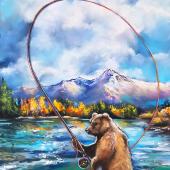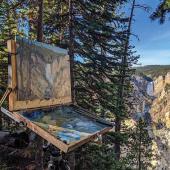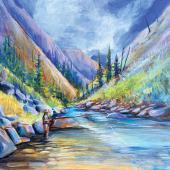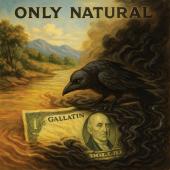The Art of Livingston
From the realistic to the ridiculous, Park County and the surrounding area has offered artistic inspiration for over a century.
The natural grandeur of the upper Yellowstone River country has beckoned artists since at least 1871, when the Hayden Expedition wandered into the strange and beautiful lands known as “Colter’s Hell” for most of the nineteenth century. Lewis and Clark expedition member-turned-trapper John Colter may have been ridiculed after describing the geysers and other thermal wonders he encountered in the area, but the U.S. government was interested. Accompanying Hayden and the first official exploration party into the region was photographer William Henry Jackson and Thomas Moran, a young artist recording his incredibly realistic impressions of the region with pencil and watercolor. Within a year, Jackson’s photos and Moran’s paintings would inspire Congress to establish Yellowstone as America’s first national park.
Moran’s Yellowstone renditions also launched the artist’s professional career. Congress allotted $10,000 to purchase his 7’ x 12’ watercolor of the Grand Canyon of the Yellowstone a few weeks after approving the Park; it became the first landscape to hang in the halls of Congress. Moran’s artistic career blossomed, and he went on to become one of the nineteenth century’s finest western landscape artists, with vivid portrayals of the Rocky Mountains, the Tetons, the deserts of the American Southwest, the Grand Canyon of the Colorado River, and more. He didn’t forget the Park’s influence on his career, however; by the mid-1870s, Moran was signing his works with the initials TYM: Thomas “Yellowstone” Moran.
The natural world is still a major influence for artists in the Park County area like Parks Reece, who moved to Livingston in 1978 in search of “more animals and less people.” Working first as curator at Livingston’s Danforth Gallery, Reece had his own gallery by 1992. Far from the realist that Moran was, Reece portrays animals doing some awfully strange things in many of his works, from a grizzly bear sending smoke signals in Send More Indians to a pair of trout smoking cigarettes in After The Spawn. Reece said he has completed from 200-300 of his “outdoor scenes with a twist” since the early ‘80s. Call Of The Wild: The Art Of Parks Reece, released by Riverbend Publishing of Helena, hallmarks the artist’s trademark style of outdoor painting, which Reece describes as “surrealism, satire, and wit.” Call Of The Wild includes 114 full-color art reproductions, and the book also contains writing and verse from Reece and his son, and area writers like Greg Keeler, Scott McMillion, and Tim Cahill.
“I’m exploring the mysteries of life,” Reece says. “I’m outdoors a lot, and I like wildlife and the natural world… and, as Tim Cahill likes to say, I have an altogether peculiar perception of the natural world.”












